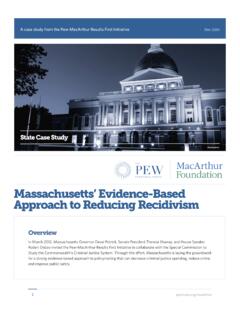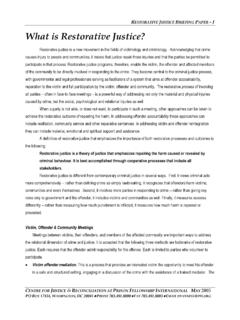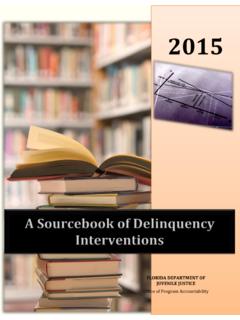Transcription of Risk/Needs Assessment 101: Science Reveals New …
1 Issue Brief Project PUBLIC SAFETY. NamePERFORMANCE PROJECT. Risk/Needs Assessment 101: Science Reveals New Tools to Manage Offenders Every day, criminal justice officials make and researchers have identified key factors decisions that have enormous implications that can help predict the likelihood of an for public safety and spending: Should individual returning to crime, violence or this offender be sentenced to prison or drug use. The instruments that have been probation? What conditions of supervision developed and fine-tuned over time to are appropriate? Does this violation of measure the likelihood of future criminal supervision warrant a revocation to prison? behavior can help officials to better identify Historically such critical decisions about individuals at a high risk of reoffending, offender punishment and treatment were while also identifying the types of guided by personal experience, professional supervision and services that are most likely judgment and a limited understanding to slow the revolving door of America's about the most effective ways to deter prisons (see Figure 1).
2 When developed offenders from committing future crimes. and used correctly, these Risk/Needs Assessment tools can help criminal justice Today our knowledge has vastly improved. officials appropriately classify offenders and After decades of experience managing target interventions to reduce recidivism, offenders and analyzing data, practitioners improve public safety and cut costs. Figure 1. Data Driven: Assessment Tools Can Accurately Identify Offender Risk A validation study of one 100%. of the most commonly used tools, the Level of 80%. Service/Case Management Inventory Recidivism Rate (LS/CMI), demonstrated 60%. its ability to accurately identify offenders' 40%. risk of 20%. SOURCE: Andrews et al, 2004 0%. Very Low Low Medium High Very High LS/CMI Risk Level september 2011.
3 Risk/Needs Assessment 101: Science Reveals New Tools to Manage Offenders 1 What Are Risk/Needs Assessment Tools? 2 How Are These Tools Used? A Risk/Needs Assessment tool is essentially Risk/Needs Assessment tools can be a uniform report card that measures customized for use by different agencies at offenders' criminal risk factors and specific various decision points in the sentencing needs that, if addressed, will reduce the and corrections process. likelihood of future criminal activity. Tools typically consist of a set of questions n Courts use Risk/Needs instruments that guide face-to-face interviews with to help make pretrial bail and release offenders, probing behaviors and attitudes decisions, sentencing and revocation that research shows are related to criminal decisions and to set conditions of reoffending.
4 The questionnaire often is supervision. supplemented with an official records n Probation and parole agencies check, including prior arrests and often use such tools to decide levels incarcerations. Responses are statistically of supervision, determine the need weighted, based on research that shows for specialized treatment programs how strongly each item correlates with (such as substance abuse, mental recidivism. The tool then calculates an health and cognitive skill building), overall score that classifies an individual's develop an offender's supervision risk of reoffending. This risk level and plan and inform decisions about accompanying information about an sanctions and revocations. offender's unique needs can then inform decisions about the best course of action.
5 N Prison and jail systems typically use risk tools to help set inmate security classification levels and identify which programs inmates should attend. n Parole boards use the instruments to guide release decisions and to set conditions of supervision. 2 Pew Center on the States Risk/Needs Assessment 101: Science Reveals New Tools to Manage Offenders Research also has identified a number of 3 What Are Criminal Risk Factors? static risk factors linked to a high risk of reoffending including age at first arrest, number of prior convictions and current Research has identified both changeable (dynamic) and unchangeable (static). 4 risk factors related to criminal behavior. Why Is It Important to Studies have revealed seven dynamic risk Differentiate Individuals factors closely associated with criminal by Risk Level?
6 Conduct that can be assessed and altered through effective Matching offenders to programs based on their risk levels is one of the keys 1. Antisocial Personality Pattern to reducing recidivism. Research has impulsive, adventurous pleasure revealed that certain intensive programs seeking, restlessly aggressive and work very well with high-risk offenders irritable behavior but actually can increase recidivism rates 2. Procriminal Attitudes offering among low-risk offenders (see Figure 2). rationalizations for crime and One program, for example, cut recidivism for high-risk offenders by more than 25. expressing negative attitudes toward percent but increased reincarceration of the law low-risk offenders by almost 18 3. Social Supports for Crime having Researchers think this counterintuitive criminal friends and being isolated finding may occur because mixing risk from prosocial peers groups exposes the lower-risk offenders to 4.
7 Substance Abuse abuse of alcohol the more destructive behaviors of higher- and/or drugs risk offenders and jeopardizes prosocial relationships and productive community 5. Poor Family/Marital engagement they may Relationships poor family relationships and inappropriate Further, risk classifications help criminal parental monitoring and disciplining justice officials maximize use of limited 6. School/Work Failure poor resources. Targeting higher-risk offenders performance and low levels of with proven programs ensures that satisfaction with school or work resources are concentrated on offenders with whom they can have the greatest 7. Lack of Prosocial Recreational impact. Activities a lack of involvement in prosocial recreational and leisure activities Risk/Needs Assessment 101: Science Reveals New Tools to Manage Offenders 3.
8 Risk/Needs Assessment 101: Science Reveals New Tools to Manage Offenders significantly improves offender outcomes, 5 How Effective Are Risk/Needs Tools? reduces recidivism and enhances public In fact, studies have demonstrated that evidence-based community Numerous studies have demonstrated that supervision and treatment strategies validated risk assessments accurately consistently reduce recidivism as much or differentiate between high-, medium- more than and low-risk offenders. In other words, individuals classified as high risk reoffend at a higher rate than those classified as low 6 What Tools Are Available? Risk/Needs assessments have become A wide range of instruments is available a cornerstone of good correctional and careful consideration should be given practice.
9 Research consistently has shown to selecting or developing an appropriate that assessing each individual's risk of Risk/Needs Assessment . Many tools are reoffending, matching supervision and available off the shelf, some of which treatment to an offender's risk level and measure only risks or needs while others targeting his or her unique criminal risk assess both. There also are specialized factors and needs with proven programs instruments that assess the risk of Figure 2. Targeting High Risk Offenders Maximizes Recidivism Reduction Low Risk A 2010 study demonstrated the +2%. effectiveness of matching offenders to +2% Moderate Risk High Risk programs by risk level. The study of 0%. 44 halfway house programs in Ohio found that the programs reduced -2%. recidivism for high-risk offenders by Recidivism Rate 10 percent but increased recidivism -4%.
10 Of low-risk offenders by two percent. One program decreased recidivism -6%. rates by more than 25 percent for -6%. high-risk offenders but increased new incarcerations by almost 18 percent for -8%. low-risk individuals. SOURCE: Latessa et al, 2010 -10%. -10%. Risk Level 4 Pew Center on the States Risk/Needs Assessment 101: Science Reveals New Tools to Manage Offenders committing certain offenses (such as sex offenses and violent offenses) or specific areas of need (such as substance abuse and mental health). A number 8 What Are the Challenges and Limitations of Risk/Needs Assessment ? of agencies have opted to modify existing instruments or to develop tools n Risk/Needs assessments cannot predict themselves. an individual's behavior with absolute precision. Inevitably there will be lower-risk offenders who reoffend 7 What Considerations Should Be Made When Implementing an and higher-risk offenders who do not reoffend.














